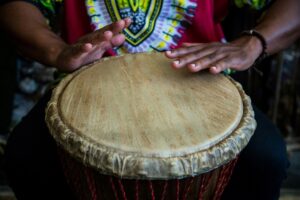Some Reflections on Drumming as Awareness Practice

I have been actively involved with studying rhythm since my late twenties. For most of that time, drumming was one of my chief recreational passions in life: a way I enjoyed relating to music and a very pleasurable way to interact with others. In hindsight, I can see that there has actually been much more to it than that. Drumming, for me, has been a form of awareness practice.
I can best convey the quality of my relationship with drumming by describing my first experience; an astonishing event that I think of as a kind of “initiation”. I had gone to a party where, as it happened, there was a woman drumming to some R & B music. I was totally transfixed by both the woman and by what she was doing. To begin with, she looked like a taller, more lithe version of me: similar hair and deep set eyes. The fluid beauty of her hands dancing back and forth on the drums was mesmerizing to watch.
She must have noticed the intensity of my attention, I suppose, because she offered the drums to me. Shy though I was, the invitation was irresistible. What happened next knocked my socks off! After striking a few tentative beats on the skins, the next thing I knew my hands were fluidly executing a fairly complex rhythm. Looking down at my hands, my amazement took the form of a question: who is doing this? I can vividly remember the feeling of it even now.
In many indigenous cultures, it is believed that rhythm is a language that connects people to the spirit world, a language which can reveal deep resources of ancient wisdom. Fascinating though I found this idea to be, I sought a less spiritual, more agnostic way to understand what had occurred. I settled on the idea of epiphany: an illuminating discovery that revealed a dimension of reality which theretofore had been totally unknown to me. Regardless, after that first experience I was hooked on drumming, I purchased conga drums and spent many thousands of hours over the next decades learning to play them; hundreds of hours lost in the ecstasy of rhythm.
There was a subjective magic in this feeling that the music was playing me. For one thing, it was the very first time I had ever experienced my sense of agency turning inside out in this way. I felt myself to be both playing the drums and yet doing nothing other than receiving what was arising. It reminded me of the artist M. C. Escher’s depiction of two hands each engaged in drawing the other with a pencil. “Channeling music” seemed a good description.
This experience subsequently generalized to other situations. While meditating on the breath, for example, there often came a moment when I began to feel that the breath was breathing me. For me, this shift in consciousness was a hallmark of entering a flow state [i] : a state in which action and awareness somehow synch to create an effortless momentum— what is colloquially termed “being in the zone”. Such states are marked by a subjective experience of being deeply focused and absorbed. When rhythmic flow is happening, it engendered (at least in me) a kind of ecstatic state in which ordinary boundaries of self-experience were transcended.
The concentration required to execute patterns of rhythm is one of the essential meditative elements of drumming. Another has to do with the fact that rhythmic grooves are of the nature to fall apart, and so one must continually re-create the groove first by listening deeply and then by letting go into the music. This, too, is akin to what happens during meditation.
When I was first studying percussion, I combed the scientific literature in search of an understanding of the neurobiology of this experience. I learned that, in a process known as neural entrainment, brainwaves (large-scale electrical oscillations in the brain) will naturally synchronize to the rhythm of periodic external stimuli, such as flickering lights, speech, music, or tactile stimuli. Neural entrainment underpins sensorimotor synchronization to dynamic rhythmic stimuli.
It seems likely that synchronized neural entrainment also occurs when a rhythmic ensemble of drummers play together. My speculation is that there are two ways that this occurs: first, as each drummer engages with the rhythm. And second, through the interaction between players, as their mirror neuron systems perceive and interact with one another. In other words, there is interpersonal rhythmic entrainment in the group. Regardless, something of this nature underlies ancient and widespread shamanistic practices in which ecstatic dance and rhythmic drumming are used to alter consciousness and create/ entrain harmonic resonance among the members of the tribal community.
It has been claimed that different rhythms entrain the brain differently dependent on the frequency (tempo) of the dominant beat. For example, rhythms in the 4 to 7 hz range are said to entrain the brain into theta, rhythms in the range of 8-12 hz entrain alpha waves, etc. The musical complexity of the rhythmic pattern also has an important influence on how the brain responds. [ii] [Independent of the influence of rhythmic entrainment, it has been shown that the experience of flow is correlated with a combination of increased theta waves in the frontal cortex along with moderate frontocentral alpha rhythm.[iii] ]
Be that as it may, what stands out for me is the idea that drumming, like meditation generally, is a form of awareness practice based on the systematic focus of attention. Concentration and deep listening are both required; attention needs to focus both on foreground (the pattern which the drummer is playing) and on surround (the rhythmic context into which the focal pattern needs to fit). The altered state of consciousness that sometimes occurred for me while I was drumming signalled to me that I was at the liminal threshold where flow was arising in my experience. It was a subjective cue to surrender to the rhythm; to let go. And, it reminded me that the vitality of rhythm could only be accessed by attending directly to experience as it was happening.
In short, drumming taught me that rhythm can be a portal into another dimension of reality and that letting go/flow is just a shift of consciousness away.
The emergence of rhythm within a confluence of percussive voices may be likened to the idea that the “music of the mind” is an emergent pattern which arises within a neural network. As Buddhist scholar Andrew Olendzki explains [iv], “mind” is not a thing but rather a set of events that occur within the neural network. Mind arises from an interdependent confluence of factors which repeatedly and reliably unfold despite the fact that “the mind” doesn’t actually exist. (In other words, mind arises co-dependently.) Similarly, though the neurons of the brain may be the stage upon which the human drama [rhythm] unfolds, it is the pattern of their firing, changing millisecond by millisecond, that brings the mind [rhythm] to life.
***********************
[i] Csikszentmihalyi, M. (2008) Flow: The Psychology of Optimal Experience. Harper Perennial Modern Classics.
[ii] Although I could not find confirmatory empirical data, novel sound healing treatments based on rhythmic entrainment are being used to repattern neurological function as a means of effecting behavioral and cognitive change. For example, Rhythmic Entrainment Intervention™ (REI) is an auditory brain stimulation program that uses musical rhythm to stimulate and re-pattern neurological function. REI is said to facilitate long-term behavioral and cognitive improvement in individuals with neurological disorders. https://www.stronginstitute.com/
[iii] Katahira, K. et.al. (2018) EEG Correlates of the Flow State: A Combination of Increased Frontal Theta and Moderate Frontocentral Alpha Rhythm in the Mental Arithmetic Task. Front Psychol. 9: 300.
[iv] Olendzki, A. (2015) The Music of the Mind: Examining the mind’s irreducibility. Tricycle Magazine, Summer 2015.
Photo credit, Luz Mendoza, UNSPLASH.
